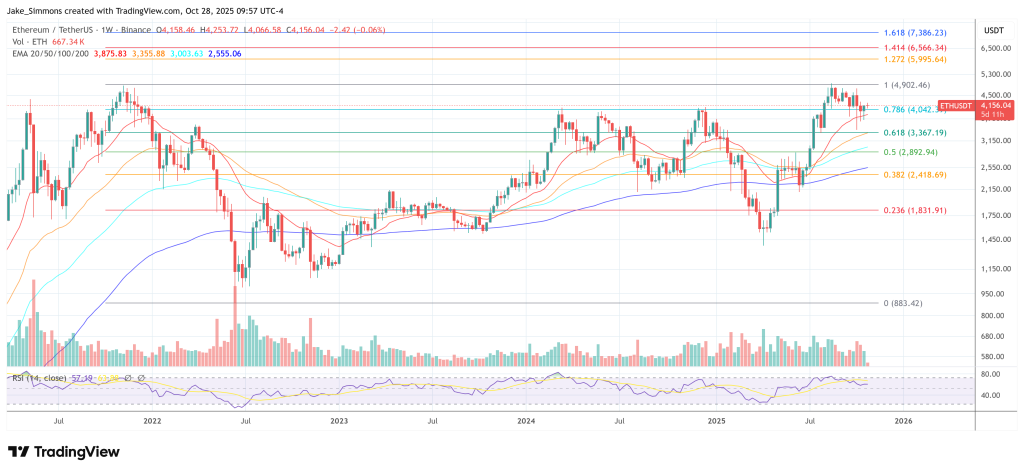Ethereum-focused treasury firm ETHZilla stated it has bought roughly $40 million price of ether to fund ongoing share repurchases, a maneuver geared toward closing what it calls a “important {discount} to NAV.” In a press assertion on Monday, the corporate disclosed that since Friday, October 24, it has purchased again about 600,000 frequent shares for roughly $12 million underneath a broader authorization of as much as $250 million, and that it intends to proceed shopping for whereas the {discount} persists.
ETHZilla Dumps ETH For BuyBacks
The corporate framed the buybacks as balance-sheet arbitrage quite than a strategic retreat from its core Ethereum publicity. “We’re leveraging the power of our steadiness sheet, together with decreasing our ETH holdings, to execute share repurchases,” chairman and CEO McAndrew Rudisill stated, including that ETH gross sales are getting used as “money” whereas frequent shares commerce beneath web asset worth. He argued the transactions could be instantly accretive to remaining shareholders.
Associated Studying
ETHZilla amplified the message on X, saying it might “use its sturdy steadiness sheet to help shareholders by buybacks, scale back shares accessible for brief borrow, [and] drive up NAV per share” and reiterating that it nonetheless holds “~$400 million of ETH” on the steadiness sheet and carries “no web debt.” The corporate additionally cited “current, concentrated brief promoting” as an element conserving the inventory underneath strain.
The market-structure logic is easy: when a digital-asset treasury trades beneath the worth of its coin holdings and money, shopping for again inventory with “coin-cash” can, in principle, collapse the {discount} and raise NAV per share. However the optics are contentious inside crypto as a result of the mechanism requires promoting the underlying asset—right here, ETH—to buy fairness, doubtlessly weakening the very treasury backing that buyers initially sought.
Demise Spiral Incoming?
Well-liked crypto dealer SalsaTekila (@SalsaTekila) commented on X: “That is extraordinarily bearish, particularly if it invitations related habits. ETH treasuries will not be Saylor; they haven’t proven diamond-hand will. If treasury firms begin dumping the coin to purchase shares, it’s a demise spiral setup.”
Skeptics additionally zeroed in on funding selections. “I’m largely curious why the corporate selected to promote ETH and never use the $569m in money they’d on the steadiness sheet final month,” one other analyst Dan Smith wrote, noting ETHZilla had simply stated it nonetheless holds about $400 million of ETH and thus didn’t deploy it on recent ETH accumulation. “Why not simply use money?” The query cuts to the core of treasury signaling: utilizing ETH as a liquidity reservoir to defend a reduced fairness might be learn as rational capital allocation, or as capitulation that undermines the ETH-as-reserve narrative.
Past the buyback, a retail-driven storyline has quickly shaped across the inventory. Enterprise Insider reported that Dimitri Semenikhin—who lately turned the face of the Past Meat surge—has focused ETHZilla, saying he bought roughly 2% of the corporate at what he views as a 50% {discount} to modified NAV. He has argued that the market is misreading ETHZilla’s steadiness sheet as a result of it nonetheless displays legacy biotech outcomes quite than the present digital-asset treasury mannequin.
Associated Studying
The identical report cites liquid holdings on the order of 102,300 ETH and roughly $560 million in money, translating to about $62 per share in liquid property, and calls out a 1-for-10 reverse cut up on October 15 that, in his view, muddied the optics for retail. Semenikhin flagged November 13 as a possible catalyst if outcomes present the pivot to ETH producing earnings.
The corporate’s personal messaging emphasizes the discount-to-NAV lens quite than a change in technique. ETHZilla informed buyers it might hold shopping for whereas the inventory trades beneath asset worth and highlighted a aim of shrinking lendable provide to blunt short-selling strain.
For Ethereum markets, the speedy move impact is restricted—$40 million is marginal in ETH’s day by day liquidity—however the second-order threat flagged by merchants is behavioral contagion. If different ETH-heavy treasuries comply with the playbook, promoting the underlying to purchase their very own inventory, the move may turn into pro-cyclical: cash are bought to shut fairness reductions, the promoting pressures spot, and wider reductions reappear as fairness screens rerate to the weaker mark—repeat.
That’s the “demise spiral” situation skeptics warn about when the treasury asset doubles as the corporate’s sign of conviction.
At press time, ETH traded at $4,156.

Featured picture created with DALL.E, chart from TradingView.com

